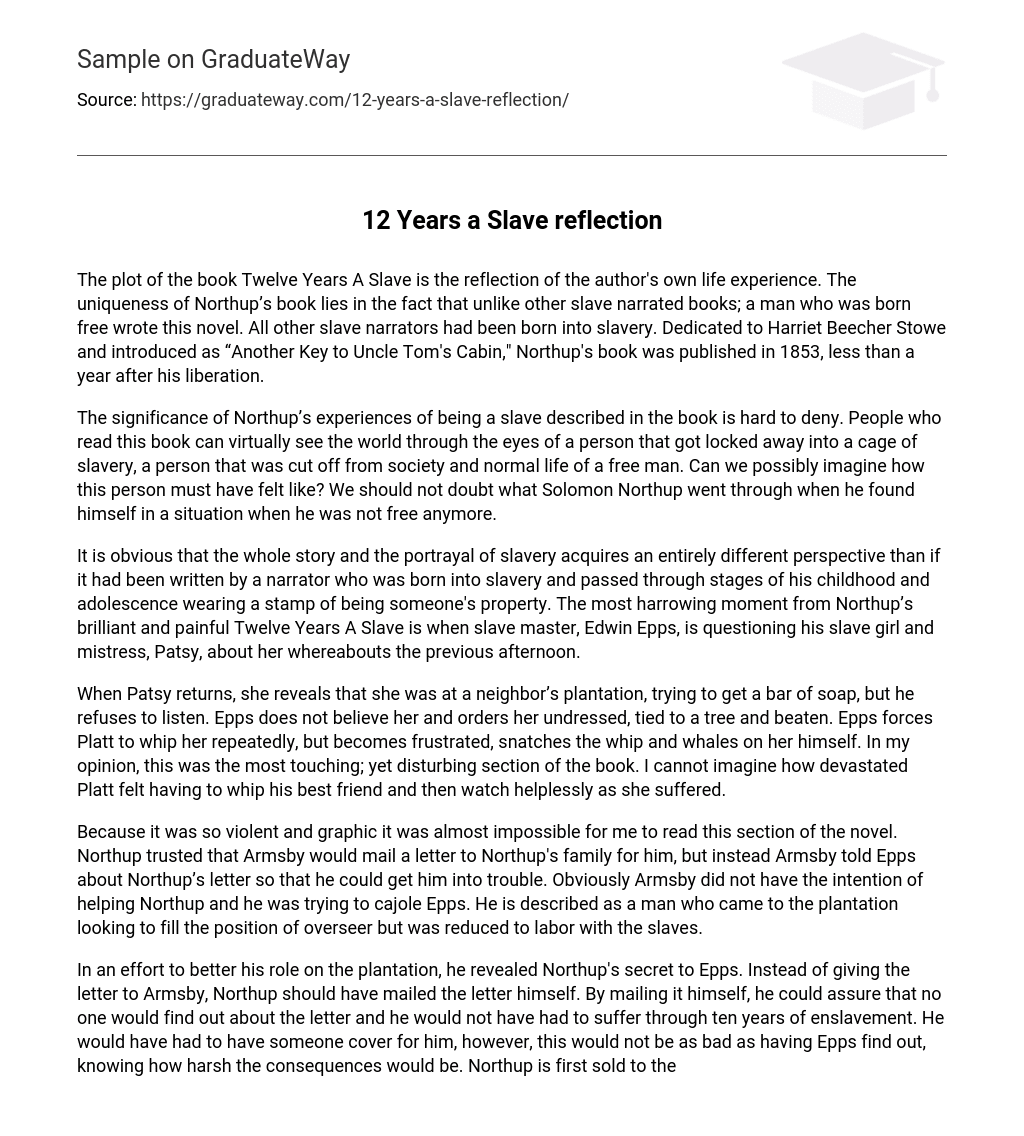The plot of the book Twelve Years A Slave is the reflection of the author’s own life experience. The uniqueness of Northup’s book lies in the fact that unlike other slave narrated books; a man who was born free wrote this novel. All other slave narrators had been born into slavery. Dedicated to Harriet Beecher Stowe and introduced as “Another Key to Uncle Tom’s Cabin,” Northup’s book was published in 1853, less than a year after his liberation.
The significance of Northup’s experiences of being a slave described in the book is hard to deny. People who read this book can virtually see the world through the eyes of a person that got locked away into a cage of slavery, a person that was cut off from society and normal life of a free man. Can we possibly imagine how this person must have felt like? We should not doubt what Solomon Northup went through when he found himself in a situation when he was not free anymore.
It is obvious that the whole story and the portrayal of slavery acquires an entirely different perspective than if it had been written by a narrator who was born into slavery and passed through stages of his childhood and adolescence wearing a stamp of being someone’s property. The most harrowing moment from Northup’s brilliant and painful Twelve Years A Slave is when slave master, Edwin Epps, is questioning his slave girl and mistress, Patsy, about her whereabouts the previous afternoon.
When Patsy returns, she reveals that she was at a neighbor’s plantation, trying to get a bar of soap, but he refuses to listen. Epps does not believe her and orders her undressed, tied to a tree and beaten. Epps forces Platt to whip her repeatedly, but becomes frustrated, snatches the whip and whales on her himself. In my opinion, this was the most touching; yet disturbing section of the book. I cannot imagine how devastated Platt felt having to whip his best friend and then watch helplessly as she suffered.
Because it was so violent and graphic it was almost impossible for me to read this section of the novel. Northup trusted that Armsby would mail a letter to Northup’s family for him, but instead Armsby told Epps about Northup’s letter so that he could get him into trouble. Obviously Armsby did not have the intention of helping Northup and he was trying to cajole Epps. He is described as a man who came to the plantation looking to fill the position of overseer but was reduced to labor with the slaves.
In an effort to better his role on the plantation, he revealed Northup’s secret to Epps. Instead of giving the letter to Armsby, Northup should have mailed the letter himself. By mailing it himself, he could assure that no one would find out about the letter and he would not have had to suffer through ten years of enslavement. He would have had to have someone cover for him, however, this would not be as bad as having Epps find out, knowing how harsh the consequences would be. Northup is first sold to the infamous Washington-based slave trader James H.
Burch, who brutally whips him for protesting that he is a free man. He is purchased by a fair-minded but feeble master named Ford. Northup writes that there never was a kinder, candid, Christian man. Northup is then sold in the winter of 1842 to John Tibeats, a quick-tempered carpenter to whom Ford had become indebted. Unlike Ford, Tibeats was never satisfied and he worked his slaves from earliest dawn until late at night. Lastly, Tibeats sells Northup to Edwin Epps, a repulsive and coarse cotton planter whom Northup describes as lacking any redeeming qualities.
Religion appears in 12 Years a Slave in its conservative theme as an eloquent technology that slave owners use to persuade their slaves to be obedient. We see Epps, for instance, preaching to his slaves and verbally underlining a Bible verse emphasizing weakness. This scene also portrays the limitations of this analysis by showing the disconnect between discourse and power. The slaves are not moved to serve by Epps’s readings, but by practice of physical and psychological violence.
Race and religion merge to become a highly effective mechanism for solidifying dignity by asserting the corruptness of outside bodies. A reader will obtain some sense of what it meant to be owned by another human being, what it meant to be considered a piece of property that could be bought and sold, an object whose sole purpose and function was to make life more comfortable for the master and his family. Readers will also be able to gain insight into the fact that despite the general cruelty, black people consciously struggled to maintain their dignity, humanity, and their moral and cultural integrity.
The book of Solomon Northup gave me a chance to go beyond what we learn in history books, taking me into the human story of slavery. Our country is founded on a system of institutional racism, and slavery is among the strongest examples of this reality. This is a hard truth to accept while at the same time enjoying the freedoms our country offers. 12 Years a Slave showed me human dignity and beauty in the face of extreme oppression. That story of slavery, not the stories of land ownership and wealth, should become the narrative of what our country stands for.





